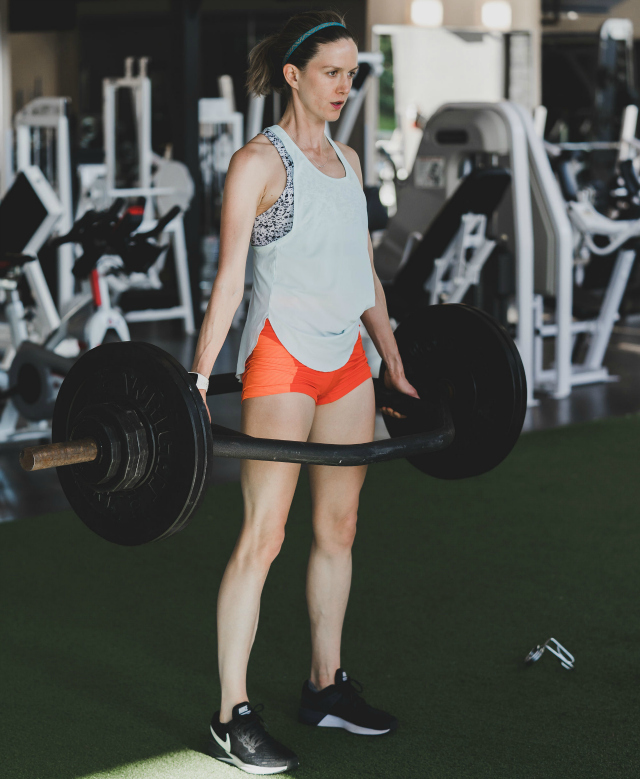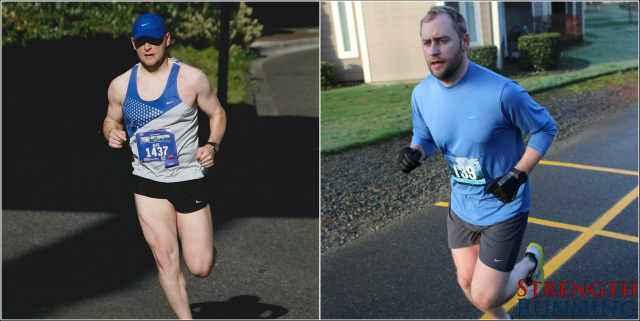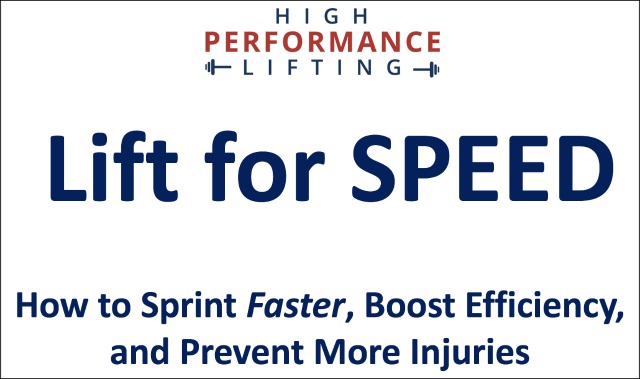Are you surprised that I don’t consider strength training exercises cross-training for runners? It’s just training!

Recently, I announced that this year is The Year of Strength. We learned that strength training exercises help runners:
- Stay healthy by preventing injuries that result from weak muscles, tendons, or ligaments
- Develop muscular power that enables speed and a fast finishing kick
- Build neuromuscular coordination that improves running economy (efficiency)
A single training tool – strength training exercises – has the ability to help you get faster, prevent injury, and run more efficiently.
Are you surprised that I’m so bullish on strength training?!
Consider how many runners will get hurt this year. Depending on the source, 35 – 80% of runners will get hurt every single year:
Stop.
Think about how crazy this is: recreational athletes engage in a sport where up to 80% of them will get hurt every year!
Keep in mind that strength training is one of the most effective prevention strategies you can implement in your training.
It would be crazy for any runner to skip strength training with an injury rate this high – since strength work is the “armor” that protects you from the stress of running.
Just imagine how much more you’d love running (not to mention, how much faster you’d run) if you could prevent more injuries, run faster, and build power into your training.
Instead of dealing with constant aches and pains, you would be a strong, powerful runner – capable of running new personal bests or joining your friends for a run any day of the week. You’d enjoy running and look forward to it, rather than fear it.
When I finally internalized the value of being strong, my running was completely transformed. But how did it look before I focused on strength work?
Injured, Weak, and in Pain
The title of this section is a summary of my college career: chronically injured, sore all the time, and pissed off that I couldn’t make it through most seasons without being hurt.
Maybe that sounds familiar… are you dealing with injury after injury, too? Just look at my college days:
- Freshman: I hurt my arch before I even stepped foot on campus. Achilles tendinopathy ruined my spring track season.
- Sophomore: IT Band injury (my “favorite”) and plantar fasciitis
- Junior: Chronic SI joint problems needed weekly adjustments and lower mileage
My final year of college (2005 – 2006) saw only one moderate injury: a strained arch in my left foot.
Because I treated it aggressively, had started strength training by that point, and pool ran every day to stay in shape the injury was short-lived. I was running (fast) in less than a week.
That year was the first (mostly) consistent year of running – and the personal bests speak for themselves:
- 8k cross country
- 800m (indoor track)
- Mile (indoor track)
- 3k (indoor track)
- 5k (outdoor track)
- 3k Steeplechase (outdoor track)
I was thrilled with my progress. A small amount of strength training provided enormous benefits and I was reaping the rewards.
My race times were getting faster. I felt stronger and I was having a lot more fun. I even won an award after cross country!
But it wasn’t enough. While I went from virtually no strength work to a few basic bodyweight routines per week, I was leaving a lot of speed and health benefits on the table.
It wasn’t until I became a coach myself that I realized how wrong I was about the value of strength exercises for runners.
Bodyweight routines are great. But without runner-specific weight lifting in the gym, no runner will ever achieve their potential.
And as a coach, that doesn’t feel right to me.
To Get Better, Emulate the Best

Olympian Kate Grace performing a deadlift in the gym
We’ve established that strength work helped my own running. But I’m just a single person (and “it worked for me” is never a good argument).
A more important question is: Does strength training work for the best runners in the world?
Whenever I wonder if a certain training strategy is legitimate, I look at how elite runners are training. Because, by definition, the best runners in the world are a model of what works.
What elite runners regularly engage in weight training?
- World’s Toughest Mudder Champion Amelia Boone
- Two-time double Olympic Gold Medalist Mo Farah
- Olympic Gold Medalist Matthew Centrowitz
- Multiple national champion Jordan Hasay
I could go on. I could also point out that Dr. Mike Young, coach to many national champions, is a strong believer in lifting for speed.
But Olympian Dathan Ritzenhein perfectly summed up the largest benefit to runners during an interview:
“The most important thing to being a good runner is developing your aerobic capacity but the longer you neglect the structure of your body the easier it is to get injured.”
Running is most important to runners. But injuries (and poorer performance) await if you don’t include strength training exercises in your running plan.
If the best runners in the world are lifting weights – and you want to achieve YOUR potential – then you should be lifting weights, too.
But first, let’s make sure the science is on board with runners in the gym doing strength exercises.
The Truth: What Strength Training DOES
We’ve learned that strength training is a critical part of training for any serious runner.
And that it helps you stay healthy, run faster, and become more efficient.
But is that for just elite runners? Do average runners like us respond the same way?
Let’s review the research (spoiler: it’s awesome).
- Strength training helps cure IT Band Syndrome (source)
- Women with runner’s knee have weaker hips than healthy runners (source – confirmed here)
- Resistance training improves trained runner’s economy by up to 8% (source)
- Explosive strength training makes your 5k faster by improved economy and muscle power (source)
- Weight lifting improves performance (speed), running economy, and muscle power (source)
I could spend days searching for studies but the consensus has already been reached. I’ve been fortunate to be able to promote weightlifting for power on places like PodiumRunner because these authoritative outlets know that more runners need to adopt strength training exercises.
And it’s incredibly rewarding to see these improvements in real-time. Meet Alan:

Alan told me that he did very little strength work – and always ended up injured. A common story, right?
Except Alan changed his story. He knew that to improve, you have to step outside your comfort zone.
After starting a strength program, Alan sent me this feedback:
I’ve noticed a remarkable change in how I feel when I run now. The strength in my hips and glutes is the highest it’s ever been, including my competition days in high school and college. This leads to a much more stable feeling when I’m out on the road.
The strength work gets me out of my comfort zone the most; I would never have thought of adding those into my training plan before. Now I appreciate them as a key contribution to my overall leg strength.
The quality of my running now is off the charts compared to before.
I’d be lying if I said that I’m not really happy with the changes that I’ve seen in my body. They’re a readily apparent reminder that I am making progress toward my overall fitness aspirations as well as my running-specific goals.
I can really sense where my hips and glutes were weak before when I thought running alone would make them strong.
And the best part?
After incorporating more strength exercises into his training, Alan ran his fastest 5k in over 10 years!
Results like this aren’t pie-in-the-sky dreams. These are real case studies of runners who have used Strength Running programs to transform themselves into the runners they know they can be.
And those results can be yours, too.
The question you have to ask yourself is, are you willing to reach out and claim these benefits as your own?
Lift like the Pro’s
Clearly, strength training exercises have the potential to absolutely transform your training:
- I’ve seen it in my own running and that of my athletes
- It’s supported by the scientific literature in countless studies
- The training programs of countless world-class runners all include a hefty dose of strength training
Now, it’s time to ask yourself some questions…
- Would you like to improve your running economy and run with less effort?
- Does being a stronger and more powerful athlete sound attractive?
- Would you like to strengthen everything from your muscles to tendons, ligaments, and everything in between?
- How would you like to avoid your next big injury?
- Would you like to be able to run faster, finish races strong, and feel more coordinated while sprinting?
The good news is that if you lift like a runner, all of these results can be yours.
It’s possible. And it won’t take you hours in the gym every day.
I’m going to demolish the most pervasive myths that surround strength training exercises for endurance runners.
You’ll learn:
- Why no runner should ever lift for endurance
- How guarding against impact can prevent your next injury
- Why it’s not necessarily how much you lift but how you lift it (movements matter!)
- And a lot more…
If you want in, then I’m excited to announce our new strength training ecourse!
Sign up here for your first coaching lesson.
This is going to be an exciting journey into the role of strength training exercises for runners with actionable examples that I think you’re going to love.
I’m stoked about this topic so get excited, join us, and prepare yourself for an incredible 2018!
